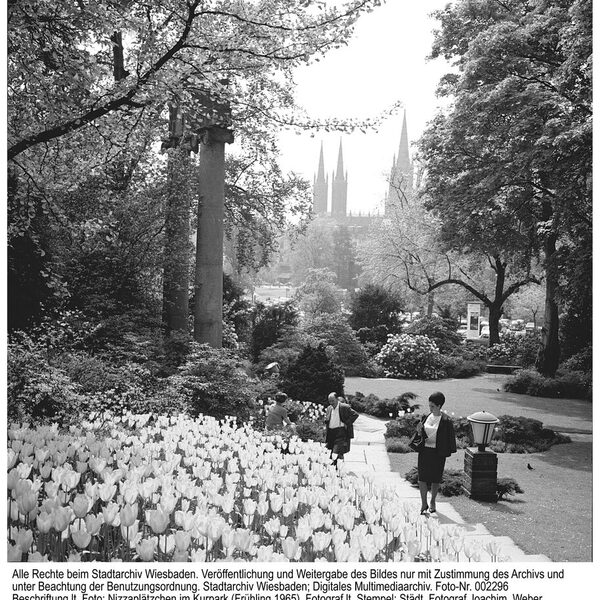Spa Park
The beginnings of the Kurpark were designed by the Nassau court gardener Johann Valentin Theobald Schweitzer in 1810-12 as a landscape park. His successor Karl Friedrich Thelemann altered and extended it in 1855/56. 75,000m2 of the park stretches from the "Hintere Kuranlage" to the Sonnenberg district over a distance of around three kilometers. In the heyday of the Wiesbaden spa in the 19th century, the spa park attracted an international audience, mainly from the aristocracy and upper middle classes.
There are a number of monuments in the Kurpark, such as the one for spa directorFerdinand Hey'l, which was created by the Berlin sculptor Hugo Berwald (1863-1937)(Ferdinand Hey'l monument), a bust of Dostoyevsky and the statue of the poet Gustav Freytag, who died in Wiesbaden, created by Fritz Schaper (1841-1919)(Gustav Freytag monument). On the picturesque Nizza-Plätzchen at the edge of the Kurpark, two pillars including a fragment of the entablature commemorate the old Gesellschaftshaus(old Kurhaus) built in 1811. A large, tree-lined concert square with a new concert shell was created between the Kurhaus and the Kurhaus pond.
The abundance of flowers in the park and the magnificent ornamental beds in front of the Kurhaus on the Bowling Green, designed and maintained by the famous "Siesmayer brothers", the leading horticultural company in the region at the time, were Hey'l, which was created by the Berlin sculptor Hugo Berwald (1863-1937)(Ferdinand Hey'l monument), a bust of Dostoyevsky and the statue of the poet Gustav Freytag, who died in Wiesbaden, created by Fritz Schaper (1841-1919)(Gustav Freytag monument). On the picturesque Nizza-Plätzchen at the edge of the Kurpark, two pillars including a fragment of the entablature commemorate the old Gesellschaftshaus(old Kurhaus) built in 1811. A large, tree-lined concert square with a new concert shell was created between the Kurhaus and the Kurhaus pond.
The abundance of flowers in the park and the magnificent ornamental beds in front of the Kurhaus on the Bowling Green, designed and maintained by the famous "Siesmayer brothers", the leading horticultural company in the region at the time, were particularly worth seeing around 1900.
Even today, the Kurpark is one of the most popular and most visited green spaces in Wiesbaden. The Kurpark, including the rear spa facilities, is a much-used green space that invites visitors to walk and cycle along the lively Rambach, which comes from the Taunus.
Literature
Sigrid Russ, editor, Denkmaltopographie Bundesrepublik Deutschland. Cultural monuments in Hesse. Wiesbaden II - The villa areas. Ed.: Landesamt für Denkmalpflege Hessen, 2nd revised edition, Stuttgart 1996 [p. 153 ff.].
